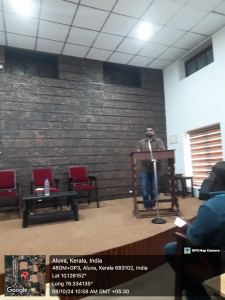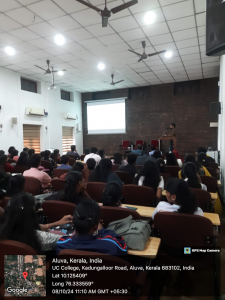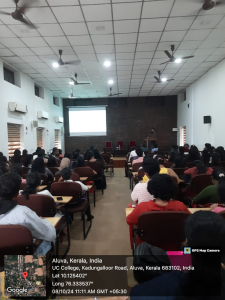
Title of Event: 𝐁𝐈𝐎𝐋𝐎𝐆𝐈𝐂𝐀𝐋 𝐏𝐑𝐎𝐗𝐈𝐄𝐒 : 𝐀 𝐊𝐄𝐘 𝐓𝐎 𝐄𝐀𝐑𝐓𝐇‘𝐒 𝐂𝐋𝐈𝐌𝐀𝐓𝐄 𝐇𝐈𝐒𝐓𝐎𝐑𝐘
Date: 08/10/2024
Time: 10:30am
Venue: TB Ninan Hall
Organized by: Post Graduate and Research Department of History and Zoology, UCC
Participants/Audience: (e.g., students, faculty, guest speakers): UG and PG Students from the department of Zoology and History, Students and faculty from Maharajas College
2. Objective
Purpose of the Event: The event aimed to:
Educate students and faculty on the importance of microfossils like diatoms, foraminifera, and other biological proxies in interpreting past environmental conditions and climate change.
Foster interdisciplinary learning by showcasing the integration of fields such as paleoceanography, paleoclimatology, and paleolimnology, encouraging students to explore new research avenues that bridge multiple scientific disciplines.
Promote awareness of contemporary climate issues, particularly in regions like the Arctic, and the use of historical data and biological proxies to better understand global environmental changes.
Inspire research interest among students by exposing them to advanced scientific methods and real-world research experiences shared by the guest speaker
3. Event Summary
Description: On October 8, 2024, an insightful seminar titled “Biological Proxies: A Key to Earth’s Climate History” was held as part of the 12th Archaeology Seminar Series. The session, delivered by Dr. Harikrishnan G., a distinguished expert in paleoceanography and diatom research, offered a comprehensive exploration of the critical role biological proxies, particularly diatoms, play in understanding Earth’s environmental and climatic history.
Dr. Harikrishnan began the lecture by introducing microfossils such as foraminifera and diatoms, a major group of algae, highlighting their immense significance in the marine ecosystem as prolific primary producers. He emphasized how diatoms, with their silica-based cell walls, are exceptional at preserving environmental information, making them valuable resources in reconstructing past climates through their fossil records.
The speaker elaborated on how diatoms serve as biological proxies, aiding in the interpretation of environmental conditions over geological timescales. He provided an overview of various types of biological proxies, including marine proxies like diatoms, lake proxies such as pollens, cave proxies like packrat middens, ocean proxies such as corals, and terrestrial proxies like tree rings and mollusk shells. These proxies help scientists analyze past environmental conditions across diverse ecosystems.
Dr. Harikrishnan offered a clear and detailed explanation of how the study of Earth’s climate history through paleoceanography, paleoclimatology, and paleolimnology is crucial. He discussed the challenges faced in historical climate data analysis, particularly in relation to temporal data limitations and isotopic composition, such as carbon-14 analysis in marine sediments. He explained how these analyses are used to reconstruct past changes in ocean temperature, salinity, and nutrient availability, refining climate models to better understand Earth’s climatic evolution.
A key section of the seminar focused on the techniques used to collect and analyze diatom samples from sediment cores. Dr. Harikrishnan illustrated how these studies enhance our understanding of significant environmental events, such as the alarming climate changes occurring in the Arctic, where temperatures are rising three times faster than the global average. The retreat of sea ice and other environmental shifts were quantified and visualized with the help of graphs, videos, and photographs, making the subject matter accessible to the audience.
Throughout the session, the speaker shared captivating research experiences and personal photographs from his fieldwork, which reflected his deep passion for the subject. The audience was inspired by the fascinating insights into the study of biological proxies and the significance of diatoms in reconstructing Earth’s climate history.
The seminar concluded with an engaging question-and-answer session, during which Dr. Harikrishnan graciously addressed a variety of queries from the attendees, further enriching their understanding of the topic.
In closing, the college extended its sincere thanks to Dr. Harikrishnan for his insightful and comprehensive seminar. His expertise and enthusiasm for biological proxies, particularly diatoms, have significantly broadened the audience’s understanding of the critical role they play in unraveling Earth’s climatic past. This knowledge will undoubtedly spark further interest and research in this important field
4. Highlights
Key Highlights: The key highlight of the seminar was its emphasis on interdepartmental and interdisciplinary approaches to learning science, particularly in the context of using biological proxies to reconstruct Earth’s climate history. The integration of fields like paleoceanography, paleoclimatology, and paleolimnology demonstrated how various scientific disciplines converge to provide a comprehensive understanding of climate change and environmental history. This approach opens new research arenas for students, encouraging them to explore interdisciplinary collaborations and think beyond traditional academic boundaries, thus fostering innovation and deeper scientific inquiry.
5. Outcome/Impact
The possible outcomes and impacts of the seminar “Biological Proxies: A Key to Earth’s Climate History” could be wide-ranging, fostering academic growth and interdisciplinary collaboration. Some key outcomes include:
Interdisciplinary Collaboration:
The lecture underscored the potential for collaboration between diverse fields such as Zoology, History, Archaeology, Geology, and Environmental Science. This opens up opportunities for joint research projects, especially in areas like climate history, biodiversity studies, and ecosystem conservation. Collaboration between the Zoology and History departments could focus on studying the historical impact of climate change on animal populations and human societies, leading to a richer understanding of environmental changes over time.
New Research Arenas:
The seminar introduced participants to innovative research areas like paleoceanography, paleoclimatology, and paleolimnology, inspiring students to explore these fields further. It could spark interest in studying biological proxies such as diatoms, foraminifera, tree rings, and coral reefs, potentially leading to new research initiatives within the college. Students may choose to investigate the impacts of historical climate shifts on local biodiversity and ecosystems, or the relationship between historical human activities and environmental changes.
Enhanced Academic Knowledge:
The lecture provided a deep dive into the techniques of studying sediment cores, microfossils, and isotopic compositions, enhancing the academic understanding of how past climate data is reconstructed. This could enrich existing curricula and inspire new course modules or workshops focused on climate history and environmental sciences, offering students hands-on opportunities to engage in fieldwork and lab-based research.
Awareness of Climate Change:
The discussion of current climate issues, particularly in sensitive regions like the Arctic, raised awareness of the ongoing impacts of climate change. Students and faculty may be inspired to take part in environmental advocacy or conservation efforts, focusing on how past environmental data can help predict and mitigate future changes.
Potential Collaborative Projects:
The event highlighted the need for collaborative studies and new subject areas across scientific and historical disciplines. These collaborative efforts could result in publications, conferences, or symposiums that further interdisciplinary research.
6. Feedback
Students appreciated the engaging presentation style of Dr. Harikrishnan, which made complex topics accessible and intriguing. They found the discussions on diatoms and their role as biological proxies particularly enlightening. Many students expressed excitement about the potential for interdisciplinary research opportunities, particularly between Zoology and History. They recognized the value of integrating different scientific fields to better understand climate history and its implications.
The seminar sparked curiosity among students about pursuing research in paleoceanography, paleoclimatology, and the study of biological proxies. Several students mentioned wanting to explore these fields further in their academic careers, indicating a desire for more courses or workshops focused on these topics.
The question-and-answer session was well-received, with students appreciating the opportunity to engage directly with the speaker. They felt that this interactive element enriched their understanding and provided a platform for deeper inquiry. Overall, the feedback reflects a strong enthusiasm among students for exploring the interdisciplinary nature of biological proxies and their relevance to understanding Earth’s climatic history, indicating a promising avenue for future academic pursuits and collaborative research initiatives.



Read the full report: